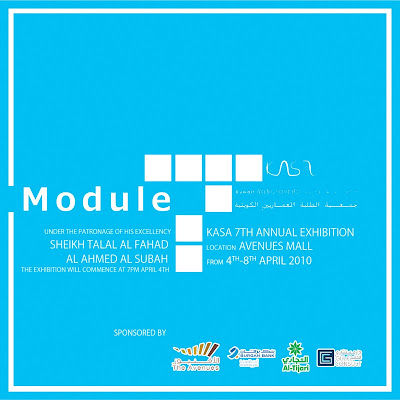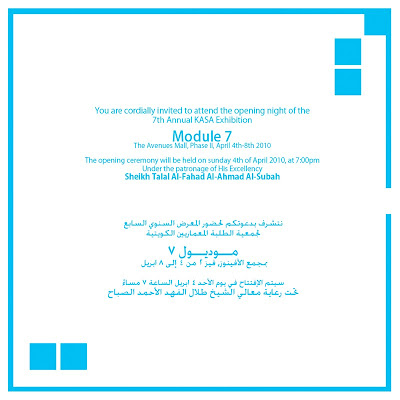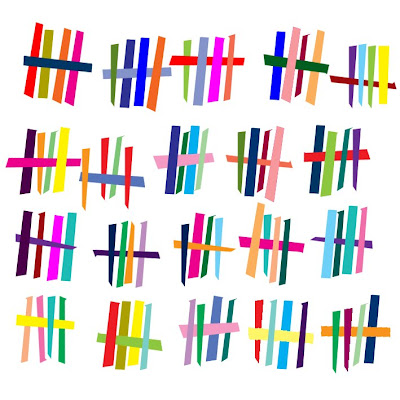
I'm teaching a class in 'Architectural Conservation & Preservation' in which we've decided to take a slightly skewed take on the topic, more of that later, but to commence this valid subject matter we're going to attempt to build a 1:5 scale space using traditional (Omani) mud-bricks. To allow us to understand what this would actually involve we managed to find and visit (thanks to my industrious and well connected students Ali and Khaled) an actual mud-brick making facility at Bahla Castle, an ongoing restoration project taking place approximately thirty-five kilometers from Nizwa. Apparently the castle's/ fort's restoration has been going on for a few decades by now, which makes it (particularly in the context of the Gulf) a unique and commendable project indeed. During our visit we had the opportunity to inspect the mud-brick making process from start to finish, the stages of which are outlined (in brief) below...
(Please click on the imags to inspect them in more detail)...
 Pits adjacent to the site where the clay is initially settled and stored...
Pits adjacent to the site where the clay is initially settled and stored...
The process starts by bringing the clay to the site where it needs to be stored in adjacent clay-pits (as seen above) for at least a month before it can be used. It has to be wetted regularily...
 A pile of clay intended for bricks...
A pile of clay intended for bricks... Once 'aged'/ settled enough to use, the clay can be adapted to two primary uses - as bricks or as mortar and screed (which seem to be more or less the same). The clay for bricks is thicker (seen above), more viscous, than the clay used as mortar (seen below) which is stored in dug out 'cubicles' also located next to the site.
 The clay used for mortar and screed...
The clay used for mortar and screed...
The clay used as mortal can seemingly be used as is, whilst the thicker clay intended for bricks needs some post-processing. This involves mixing it with dry straw, done manually by foot (in a somewhat similar fashion to crushing grapes for wine - see image below) as well as shovel, at a roughly 3/4 clay - 1/4 straw ratio (or 1 wheel-barrow of clay, 2 bucket fulls of straw). This mixture is allowed to settle for a day...
 Mixing clay, water and straw for the mud-bricks...
Mixing clay, water and straw for the mud-bricks...
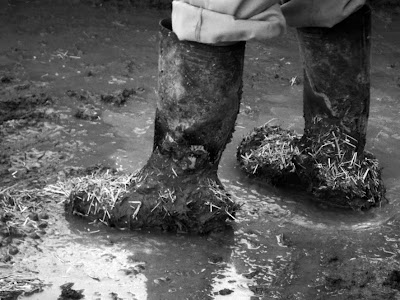 Their boots act as evidence of their tramp-led/ing toils...
Their boots act as evidence of their tramp-led/ing toils... Delivery of mixed (brick making) goods...
Delivery of mixed (brick making) goods...
The mixed clay is brought to the brick making site in wheel-barrows, where it is put into molds (see below) and allowed to dry for five days in the shade and two additional days exposed to the sun. The most common brick size is 30 x 15 x 15 altough the option of making them 35 x 15 x 15 or 13 x 10 x 15 also exists... The workers at the Bahla site made on average between 250 - 400 mud-bricks a day...
 Making mud bricks...
Making mud bricks...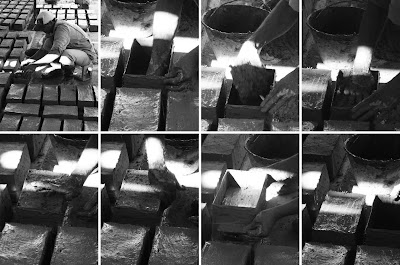 The mud-brick making process - The inside of the mold is lubricated with a watery coat of clay; the clay is packed into the mold up to its rim and the top surface is flattened and smoothed by hand; the mold is lifted off the brick and the process is repeated...
The mud-brick making process - The inside of the mold is lubricated with a watery coat of clay; the clay is packed into the mold up to its rim and the top surface is flattened and smoothed by hand; the mold is lifted off the brick and the process is repeated...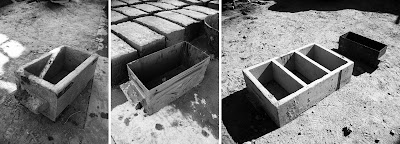 A few examples of different, both wood and metal, molds used...
A few examples of different, both wood and metal, molds used...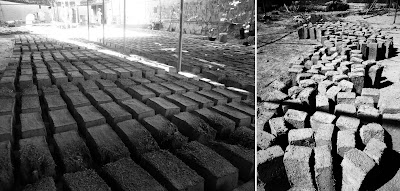 The mud-bricks are allowed to dry for five days in the shade, and two additional days exposed to the sun...
The mud-bricks are allowed to dry for five days in the shade, and two additional days exposed to the sun...
Included below are some additional images from the Bahla Castle/ Fort in which restoration the bricks are used.
Regarding our project we eventually plan to take what we learn from making the bricks ourselves and expand on the remit to hopefully also include a updated/ adjacent take on what using such materials and processes could actually entail. This might involve experimenting with alternative binding materials to straw (look at
GRC as an example) or, say, apply some lessons from contemporary
rammed earth construction (updates will be included as the project progresses)...
 Bahla Castle/ Fort...
Bahla Castle/ Fort...
